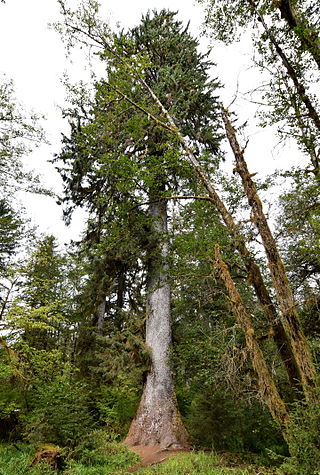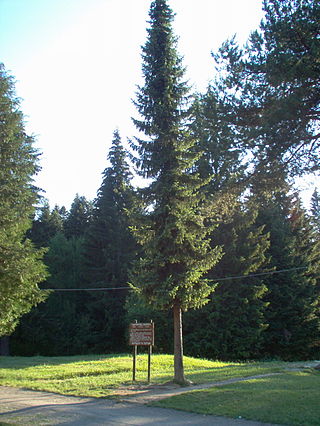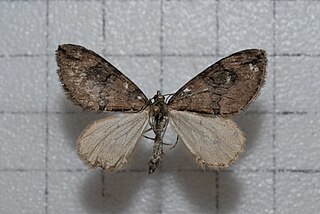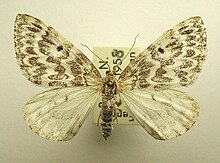
A spruce is a tree of the genus Picea, a genus of about 40 species of coniferous evergreen trees in the family Pinaceae, found in the northern temperate and boreal (taiga) regions of the Earth. Picea is the sole genus in the subfamily Piceoideae. Spruces are large trees, from about 20 to 60 m tall when mature, and have whorled branches and conical form.

Picea mariana, the black spruce, is a North American species of spruce tree in the pine family. It is widespread across Canada, found in all 10 provinces and all 3 territories. It is the official tree of the province of Newfoundland and Labrador and is that province's most numerous tree. The range of the black spruce extends into northern parts of the United States: in Alaska, the Great Lakes region, and the upper Northeast. It is a frequent part of the biome known as taiga or boreal forest.

Picea abies, the Norway spruce or European spruce, is a species of spruce native to Northern, Central and Eastern Europe.
In the scientific name of organisms, basionym or basyonym means the original name on which a new name is based; the author citation of the new name should include the authors of the basionym in parentheses. The term "basionym" is used in both botany and zoology. In zoology, alternate terms such as original combination or protonym are sometimes used instead. Bacteriology uses a similar term, basonym, spelled without an i.

Picea sitchensis, the Sitka spruce, is a large, coniferous, evergreen tree growing to almost 100 meters (330 ft) tall, with a trunk diameter at breast height that can exceed 5 m (16 ft). It is by far the largest species of spruce and the fifth-largest conifer in the world, and the third-tallest conifer species. The Sitka spruce is one of the few species documented to exceed 90 m (300 ft) in height. Its name is derived from the community of Sitka in southeast Alaska, where it is prevalent. Its range hugs the western coast of Canada and the US, continuing south into northernmost California.

Picea omorika, commonly known as the Pančić spruce or Serbian spruce, is a species of coniferous tree endemic to the Drina River valley in western Serbia, and eastern Bosnia and Herzegovina, with a total range of only about 60 ha, at 800–1,600 m (2,600–5,200 ft) altitude. It was originally discovered near the Serbian village of Zaovine, on Mount Tara, in 1875, and named by the Serbian botanist Josif Pančić; the specific epithet omorika is simply the Serbian word for the tree.

Picea engelmannii, with the common names Engelmann spruce, white spruce, mountain spruce, and silver spruce, is a species of spruce native to western North America. It is mostly a high-elevation mountain tree but also appears in watered canyons.

The blue spruce, also commonly known as green spruce, Colorado spruce, or Colorado blue spruce, is a species of spruce tree native to North America in Arizona, Colorado, Idaho, New Mexico, Utah and Wyoming. It is noted for its blue-green colored needles, and has therefore been used as an ornamental tree in many places far beyond its native range.

Picea jezoensis, the dark-bark spruce, Ezo spruce, Yezo spruce, or Jezo spruce, is a large evergreen tree growing to 30–50 m tall and with a trunk diameter of up to 2 m. It is native to northeast Asia, from the mountains of central Japan and the Changbai Mountains on the China-North Korea border, north to eastern Siberia, including the Sikhote-Alin, Kuril Islands, Sakhalin and Kamchatka. It is found in cold but humid temperate rain forests, and nowhere does its range extend more than 400 km from the Pacific Ocean. The specific epithet jezoensis derives from Ezo, an old name for Hokkaido and other islands north of the Japanese island of Honshu, where the species is found.

Picea orientalis, commonly known as the Oriental spruce or Caucasian spruce, is a species of spruce native to the Caucasus and adjacent northeast Turkey.

White spruce is a common name for several species of spruce (Picea) and may refer to:

Picea smithiana is a species of evergreen tree in the family Pinaceae family. It is referred to by the common names morinda spruce and West Himalayan spruce, and is a spruce native to the western Himalaya and adjacent mountains, from northeast Afghanistan, northern Pakistan, India to central Nepal. It grows at altitudes of 2,400-3,600 m in forests together with deodar cedar, blue pine and pindrow fir.

The Cidariini are the largest tribe of geometer moths in the subfamily Larentiinae. The Cidariini include many of the species known as "carpets" or, ambiguously, "carpet moths", and are among the few geometer moths that have been subject to fairly comprehensive cladistic study of their phylogeny. The tribe was described by Philogène Auguste Joseph Duponchel in 1845.

The Cameroonian shrew is a species of mammal in the family Soricidae. It is endemic to Cameroon. Its natural habitat is subtropical or tropical moist montane forests. It is threatened by habitat loss.

Arara is a municipality in the state of Paraíba in northeastern Brazil. It is located in the mesoregion of Agreste Paraibano and the microregion of Western Curimataú, 155 km from the state capital, João Pessoa. It is located on the high plain of Borborema at an altitude of 467 m above sea level.

Spruce-pine-fir (SPF) is a classification of lumber that can be traded on commodities exchanges.

Heterothera is a genus of moths in the family Geometridae described by Hiroshi Inoue in 1943.

Serraria is a neighbourhood (bairro) in the city of Porto Alegre, the state capital of Rio Grande do Sul, in Brazil. It was created by Law 6893 from September 12, 1991.

Heterothera sororcula is a moth in the family Geometridae first described by Max Bastelberger in 1909. It is found in Taiwan.

Plantago serraria is a species of plants in the family Plantaginaceae.

















